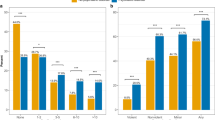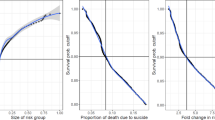Abstract
We attempted to predict revolving door (RD) patterns of admission (four or more admissions with less than 2.5 years between consecutive admissions) in a random sample of 10% of all first admissions to psychiatric hospitals and psychiatric wards of general hospitals in Israel from 1983 to 1990 with follow-up into 1993. This included 4570 hospitalizations of 2220 patients. Data were extracted from the National Psychiatric Case Registry of the Ministry of Health. Almost 59% of the sample had only one admission, 41% had two or more, 23% had three or more, and 14% had four or more admissions. Patients with four or more admissions were all RD patients. They had an average of 200 days between admissions. The average number of admissions for RD patients was 6.17, and the average number of years between the first admission and the last admission was 3.28 years. Using discriminant analysis were correctly predicted 73.9% of the non-RD group (about chance level since 80% of the cases were non-RD) and 71.2% of the RD group (considerably better than chance, only 12.0% of the sample were RD). The main predictors of RD in descending order were not being married at the time of first hospitalization, unemployment and more severe initial diagnosis. The minor predictors were older age, more education and longer first admission. Substance abuse, patients ability to care for their affairs, voluntary status of first admission and suicide attempts did not predict RD. The predictors of RD were almost the same as predictors of more than one admission. We were not able to identify a variable that clearly differentiated between the two or more, three or more and four or more admissions groups. Variability between hospitals is also presented.
Similar content being viewed by others
References
Barnea T, Rahav G, Teichman M, Rosenblum I (1990) The use of drugs and alcohol among residents of Israel: epidemiological study
De Francisco D, Anderson D, Pantano R, Kline F (1980) The relationship between length of hospital stay and rapid-readmission rates. Hosp Community Psychiatry 31: 196–197
Friedman S, Feinsilver DL, Davis GW, Margolis R, David OJ, Kesselman M (1981) Decision to admit in an inner-city psychiatric emergency room: beyond diagnosis — the psychosocial factors. Psychiatr Q 53: 259–274
Joyce PR, Khan A, Jones AV (1981) The revolving door patient. Compr Psychiatry 22: 397–403
Kanwischer RW, Hundley J (1990) Screening for substance abuse in hospitalizing psychiatric patients. Hosp Community Psychiatry 41: 795–797
Kastrup M (1987a) Sex differences in the utilization of mental health services: a nation-wide register study. Int J Soc Psychiatry 33: 171–184
Kastrup M (1987b) The use of a psychiatric register in predicting the outcome “revolving door patient”: a nation-wide cohort of first time admitted psychiatric patients. Acta Psychiatr Scand 76: 552–560
Kastrup M (1987c) Who became revolving door patients. Acta Psychiatr Scand 76: 80–88
Lerner Y, Popper M, Zilber N (1989) Patterns and correlates of psychiatric hospitalization in a nationwide sample: I. Patterns of hospitalization with special reference to the “new chronic” patients. Soc Psychiatry Psychiatr Epidemiol 24: 121–126
Morin RC, Seidman E (1986) A social network approach and revolving door patients. Schizophr Bull 12: 262–273
Rose SO, Hawkins J, Apodaca L (1977) Decision to admit. Arch Gen Psychiatry 34: 418–421
Rosenblatt A, Mayer JE (1974) The recidivism of mental patients: a review of past studies. Am J Orthopsychiatry 44: 697–706
Safer DJ (1987) Substance abuse by young adult chronic patients. Hosp Community Psychiatry 38: 511–514
Smith JW (1983) Diagnosing alcoholism. Hosp Community Health 34: 1017–1021
Woogh CM (1986) A cohort through the revolving door. Can J Psychiatry 31: 214–221
Woogh CM, Meier HMR, Eastwood MR (1977) Psychiatric hospitalization in Ontario: the revolving door in perspective. Can Med Assoc J 116: 876–881
Zilber N, Popper M, Lerner Y (1990) Patterns and correlates of psychiatric hospitalization in a nationwide sample. II. Correlates of length of hospitalization and length of stay out of hospital. Soc Psychiatry Psychiatr Epidemiol 25: 144–148
Author information
Authors and Affiliations
Rights and permissions
About this article
Cite this article
Rabinowitz, J., Mark, M., Popper, M. et al. Predicting revolving-door patients in a 9-year national sample. Soc Psychiatry Psychiatr Epidemiol 30, 65–72 (1995). https://doi.org/10.1007/BF00794944
Accepted:
Issue Date:
DOI: https://doi.org/10.1007/BF00794944




